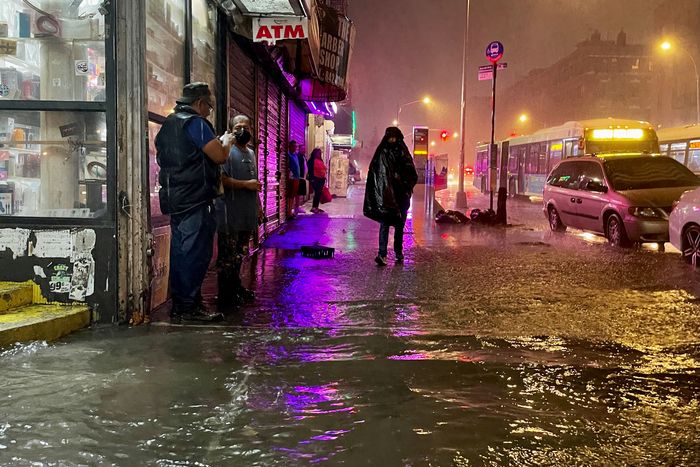
In the nine years since Superstorm Sandy rolled over New York, pushing walls of water onshore, the city has approached resiliency with a multipronged approach: crossed fingers, wishful thinking, and galvanizing panic. We have some new building codes, a few new parks, tunnels fitted out with floodgates, proposals for ocean barriers, and plans for coastal hills, and offshore neighborhoods — projects so slow, costly, and controversial that they seem designed to maximize procrastination. We have confronted the urgency of climate change — one aspect of it, anyway — with a distinctively New York mixture of big dreams and indolence. In the last two weeks, a new pair of harbingers, Henri and Ida, arrived to remind us that the danger comes from the sky as well as the sea. A multibillion storm barrier won’t fend off flooding from biblical rains.
The good news is that adapting the city to an ever-more-relentless rhythm of downpours doesn’t necessarily require massive public works on the scale of the Pyramids of Giza. Yes, the sewer system is antique and in need of expensive modernization. The subway will need to build out the more robust defenses it’s been testing. But the most urgent, and most fixable, challenge is that we have the wrong kind of streets.
When rain assaults New York, it slams against asphalt first, a 6,000-mile waterproof crust. Unable to soak into the ground, stormwater swirls into gutters and washes past trash-clogged drains. Along the way it picks up a cargo of noxious effluvia and deposits it into whatever depressions it can find: basements, subway stations, Brooklyn. The collision of natural forces with manmade barriers exacerbates the problem. Concrete barriers along the shoulders turn highways into swimming pools. Water that’s repelled in one spot pushes off to find somewhere else to invade. The city does the equivalent of mopping up an overflowing toilet with a rock.
We have alternatives: streets designed to let a downpour soak into the ground, where layers of soil, sand, clay, and rock can store it for a while, filter out pollutants, and let it drain slowly away. The techniques are already in use, just not widely enough. The National Association of Transportation City Officials has put out a primer on how to design streets to handle stormwater by making them not just more functional, but also more beautiful and livable. Bioswales — shallow, asphalt-free areas planted with grasses — can ennoble the streetscape even as they perform their plumbing tasks. Some vulnerable areas (Gowanus, say) need costly underground cisterns to prevent large quantities of polluted runoff from dumping right into the waterways, but in the absence of plastified streets and concrete channels, nature does a pretty good job of handling floods on its own. More than seven inches of rain fell in Central Park during Ida’s passage, and by next morning the ground was squishy but mostly un-waterlogged.
Nearly a dozen years ago, as part of MoMA’s prescient exhibition “Rising Currents,” the architecture firms Architecture Research Office and DLANDStudio proposed webbing lower Manhattan with absorptive green streets. Other designers, too, have imagined weaving nature more inextricably through the urban fabric, not just for pleasure but as a form of defense. In renderings, these ideas tend to look whimsical, like a city planned by elves. But making streets spongier is both achievable and urgent. Digging up and replacing thousands of miles of roadway is a massive task, but it’s one that’s already underway, all the time. In 2018, the de Blasio administration boasted that it had repaved more than a quarter of New York’s lane miles in four years. And that’s not counting the utility companies’ scattered but ceaseless hole-digging and patching that so enlivens city nights. Those operations could be transformative over time — and not even that much time. Nearly a decade has passed since Sandy, a decade in which thousands of miles of streets might have been studded with bioswales and resurfaced with permeable pavers and porous asphalt instead of one more layer of impermeable flood accelerator.
Those paving technologies are not new, but they are also not fully proven at the scale of a whole city. The literature about them is peppered with phrases like “pilot project” and “further research,” a giveaway that progress has been desultory. Porous asphalt is still something of a boutique product, which makes it relatively expensive — a problem that New York might solve almost singlehandedly by creating its own massive market. The enemy is habit. When it’s time to repave a stretch of roadway, every transportation department in the world will opt for the cheapest, fastest solution — that is, the one that it’s already carried out a million times before. But in the era of climate change, inertia is lethal.





